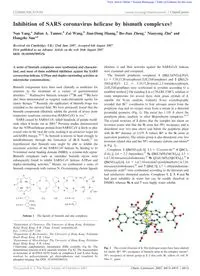
2007 Inhibition of SARS coronavirus helicase by bismuth complexes PDF
Preview 2007 Inhibition of SARS coronavirus helicase by bismuth complexes
Inhibition of SARS coronavirus helicase by bismuth complexes{ Nan Yang,a Julian A. Tanner,b Zai Wang,b Jian-Dong Huang,b Bo-Jian Zheng,c Nianyong Zhua and Hongzhe Sun*a Received (in Cambridge, UK) 22nd June 2007, Accepted 6th August 2007 First published as an Advance Article on the web 16th August 2007 DOI: 10.1039/b709515e A series of bismuth complexes were synthesized and character- ized, and most of them exhibited inhibition against the SARS coronavirus helicase ATPase and duplex-unwinding activities at micromolar concentrations. Bismuth compounds have been used clinically as medicines for centuries in the treatment of a variety of gastrointestinal disorders.1–7 Radioactive bismuth isotopes (212Bi and 213Bi) have also been demonstrated as targeted radio-therapeutic agents for cancer therapy.5,8 Recently, the application of bismuth drugs was extended to the antiviral field. We have previously found that the bismuth compounds efficiently inhibit the growth of severe acute respiratory syndrome coronavirus (SARS-CoV) in vivo.9 SARS caused by SARS-CoV, killed hundreds of people world- wide when it broke out in 2003.9 Previous studies demonstrated that the NTPase/helicase protein from SARS-CoV is likely to play crucial roles in the viral life cycle, making it an attractive target for anti-SARS therapy.10–12 As bismuth is known to bind strongly to metallothionein through the formation of Bi–S bonds,13 we hypothesized that bismuth ions might be able to inhibit the enzymatic activities of the SARS-CoV helicase by binding to its N-terminal metal binding domain (MBD), a cysteine-rich region. Bismuth complexes such as ranitidine bismuth citrate were subsequently found to inhibit SARS-CoV helicase ATPase and duplex-unwinding activities.9 Herein, we synthesized a series of bismuth compounds with various N, O-containing chelate ligands (Scheme 1) and their activities against the SARS-CoV helicase were examined and compared. The bismuth porphyrin complexes 1 ([Bi(L1)(NO3)]?H2O, L1 = 5,10,15,20-tetraphenyl-21H,23H-porphine) and 2 ([Bi(L2)- (NO3)]?H2O, L2 = 5,10,15,20-tetra(1,2,3-trimethoxyphenyl)- 21H,23H-porphine) were synthesized in pyridine according to a modified method.{ On standing 2 in a CH3OH–CHCl3 solution at room temperature for several days, dark green crystals of 2, suitable for X-ray analysis, formed.§ X-ray crystallography revealed that Bi3+ coordinates to four nitrogen atoms from the porphyrin ring and an oxygen atom from a nitrate in a distorted pyramidal geometry (Fig. 1). The metal lies 1.339 A˚ above the porphyrin plane, similarly to other Bi-porphyrin complexes.14,15 The crystal structure of 2 shows that the complex lies about an inversion centre and that the Bi atom has 50% occupancy and is disordered over two sites above and below the porphyrin plane with Bi–Bi* distance of 2.679 A˚ (where Bi* is the Bi atom at equivalent position). The nitrate group is also disordered over two inversion related sites and has 50% occupancy (nitrate and nitrate* in Fig. 1). Complexes 3 ([Bi(NO3)3(L3)], L3 = 12-crown-4),16 4 ([BiCl3- (L4)1.5], L4 = 2,29-bipyridine),17 5a ([Bi(L5)(H2O)(ClO4)3], L5 = 1,4,7,10-tetraazacyclododecane),18 5b ([Zn(L5)(H2O)](ClO4)2),19 6 ([Bi(NO3)4(L6)], L6 = 1,4,7,10-tetrakis(2-pyridylmethyl)-1,4,7,10- tetraazacyclododecane),20 and 7 ([Bi(L7)], L7 = ethylenediamine- tetraacetic acid)21 were synthesized according to the literature and had satisfactory elemental analysis. Complexes 1, 2, 3, 4 and 5a had poor solubility in water but can be readily dissolved in DMSO, whereas 5b, 6 and 7 were highly water soluble. aDepartment of Chemistry, The University of Hong Kong, Pokfulam Road, Hong Kong, P.R. China. E-mail:
